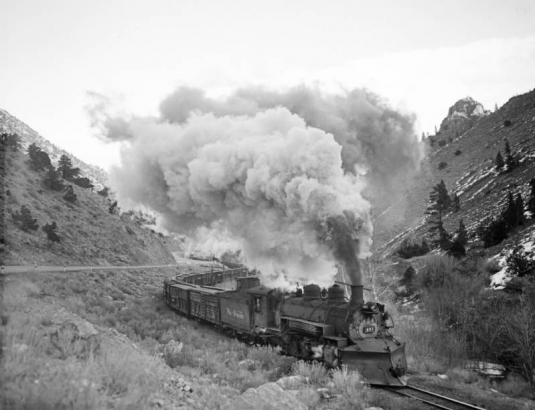*Posted on behalf of Jacqueline Frisina.
Recently, I finished a project to digitize negatives of historic railroads in Colorado, and uploaded them to the Denver Public Library (DPL) digital collections. This project, funded by the Colorado Historical Records Advisory Board (CHRAB) grant, was a collaborative effort between DPL and the Colorado Railroad Museum (CRRM), and resulted in 413 historic railroad images that are now available to the public. I interviewed Stephanie Gilmore, Curator of Collections at CRRM, and Tom Madden, a long-time volunteer at CRRM, to gain their perspective on what it means for CRRM to have these collections online.
The following interview has been edited for length and format.
Can you tell me a little bit about the history of railroads in Colorado, and what it meant?
Stephanie: I would say that the railroads built the state of Colorado! They had a huge part in populating the state, from mining to transportation. Our state is like a spiderweb of trackage if you look at historic maps of where all the narrow gauge lines went, and many don’t exist anymore. It’s pretty interesting.
Tom: The railroads made it possible to exploit the mineral riches of Colorado. And that was the only form of transportation that could be built quickly and relatively inexpensively, and had the capacity to haul heavy loads through these mountain valleys.
Out of all the images that you have in your institution, what drew you to select these ones?
Tom: Charlie Albi, a volunteer and historian, suggested we do the Hallock collection because he felt that it contained a lot of Colorado images. The guideline for the CHRAB grant was to choose images that were Colorado subjects, and both the Hallock and Buvinger collections included a lot of Colorado subjects. Hallock ranged fairly wide - out of Denver, up into Wyoming, and out of the eastern plains - and his images reflect that. Buvinger was more constrained to the Denver area. His collection has value because it’s very comprehensive and thorough coverage of a smaller area over a specific period of time. Even though the individual images might not be all that interesting or valuable, as a collection, it gives a great snapshot of the railroad history of that time in the late 50’s.
What is the significance for CRRM to have the Hallock and Buvinger collections online, and what impact do you anticipate?
Stephanie: It is really tremendous. The popularity is there - there’s a large railfan contingent that loves rail photography, and having these two particular photographers represented in our collection and online will help us reach a wider audience, and will show people what beautiful photographs we do have. I appreciate the collaboration between DPL and CRRM so that we can continue to work together on other projects. I think that's really a great impact for both of our institutions.
How was working and collaborating with DPL to receive the CHRAB grant, and implementing the processes for the project?
Tom: I don’t think there were really any challenges - we had great communication. When questions came up, they were put forth, and we answered them as best we could. There were a couple of negative mix-ups, and we recovered from that very nicely. We got our correct number of negatives, and there just really weren't any challenges.
Stephanie: It was very, very easy. DPL wrote the grant portion and I filled in a little bit. We chose the photographers, and provided a bio from a book. Working with DPL has been really smooth.
Something interesting that I learned was that the Curecanti Needle at the Black Canyon of the Gunnison National Park was often used in ads for the Denver and Rio Grande Western railroad. What is something interesting that you learned about railroads through your job at CRRM?
Tom: I came to the museum knowing this stuff. Most volunteers came to the museum with the body of knowledge - they didn’t come to learn, so much as to serve.
Stephanie: Which is an interesting notion that I had not seen in previous museums that I worked in. I am not a railroad expert, and I wasn’t one when I started this job. So, through this project I learned about Hallock and Buvinger. I had heard the name Buvinger before, and I knew that we had a large collection of his photographs, but I didn’t know the significance of either man. So, I’ve learned about those two gentlemen through this project.
Is there anything else that you’d like to add?
Stephanie: I appreciate the grant, and I appreciate that you guys reached out to us to do it, so thank you for that. And hopefully there will be more to come in the future, because it was a nice project.


Comments
A treat to see these photos.
A treat to see these photos. They are a time machine, in a sense.
I met quite a few interesting rail fans who felt tasked to preserve
a slice of history during my time at CRRM.
We were thrilled to be a part
We were thrilled to be a part of this project!
I have a friend in the UK who
I have a friend in the UK who's a train nut. I sent this to him so he can link up to your digital images. He's been enjoying it tremendously.
Thanks for sharing our work
Thanks for sharing our work with our friends across the pond!
Add new comment